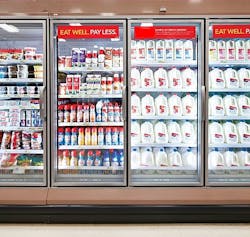LED lighting in grocery cases can degrade milk, according to researchers in Cornell's Department of Food Science, with exposure times as short as four hours impacting product quality.
Cornell University has published new research that suggests that LED-based grocery case lighting adversely impacts the quality of refrigerated milk in as little as four hours. The blue spectral-energy peak that's inherent in phosphor-converted white LEDs that are based on blue emitters is the culprit, according to the research team in the Department of Food Science. The lead author of the study is Nicole Martin; other authors include Nancy Carey, Steven Murphy, David Kent, Jae Bang, and Tim Stubbs.
Interested in articles & announcements on life science applications of LED lighting?
Refrigerator grocery case lighting was one of the first lighting applications in which the solid-state lighting (SSL) alternative to fluorescent tubes gained a foothold. We ran a feature article on the topic back in 2012, but the transition to LEDs in such cases began years earlier. LEDs offer reliable operation in the cold environment, do not generate heat that would increase refrigeration electrical costs, and provide directional light to better focus on the merchandise. So grocers were quick to buy into the SSL revolution.
But the latest research may change things, at least in dairy cases. The research is summarized on the Cornell Chronicle website through which the university distributes research news to the media. The researchers stated that it has been well understood that exposure to sun and artificial light could degrade "milk sensory quality and nutritional content." Apparently riboflavin and other elements in milk are photosensitive and riboflavin absorbs light in a narrow band that is in the same range as the typical blue peak of LEDs in the 460-nm range.
The impact of the LED lighting doesn't spoil the milk but simply degrades the quality. The researchers had test subjects taste milk that had been under LED lights for as little as four hours and compare the taste to milk that has been stored for two weeks but shielded from LED exposure. The testers overwhelmingly preferred the older milk over the LED-exposed milk. The milk exposed to LED lighting was said to taste of "cardboard or plastic."
The research could lead to changes in lighting or packaging practices. Researchers said the LED lighting even impacts milk in opaque plastic packages. Of course, some milk is packaged in cartons or even inside boxes in big-box retailers through which the blue energy would not pass. But some retailers might choose to go away from LED lighting, or perhaps specify LED technology with lower CCT and higher CRI that inherently has a much less powerful blue peak.
We've regularly written about the presumed danger to human eyes relative to the blue peak. Indeed, we had a feature article on the topic last year. But people rarely get direct and extended exposure to LED or legacy light sources. Milk, conversely, sits under case lighting for 24 hours a day in many settings.
Ironically, LED lighting has been proven to be a positive factor in preserving and lengthening the shelf life of some food products. For example, we covered research that showed ultraviolet (UV) LEDs could extend the life of strawberries.
Moreover, LED lighting on dairy farms has been used to increase milk production. Last year, research at a Michigan dairy described how LEDs are being used to artificially lengthen daylight hours which in turn can boost milk production by 8%. But LED lighting may not be appropriate throughout the milk supply chain.






